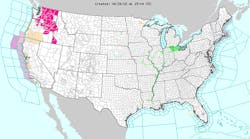In the coming days, temperatures across the northwest are expected to set records and reach triple digits in some areas. That’s why Washington’s Department of Labor & Industries is urging people working outdoors to take precautions against heat-related illness, a condition that can result in serious medical problems, including disability or death.
Roofing, highway construction and agricultural work are just a few of the jobs across the northwest in which workers are vulnerable to heat-related illnesses when temperatures rise.
Outdoor workers are encouraged to follow these five tips to beat the heat:
1. Start work well hydrated and drink as much as a cup of water every 15 minutes.
2. Watch co-workers for signs of heat-related illness, including headaches, dizziness or nausea.
3. Pace your work and take scheduled breaks in the shade.
4. Wear lightweight clothing and remove protective gear when it’s safe to do so.
5. Avoid drinking caffeine or eating a heavy meal.
Along with the direct health effects of working in extreme heat, heat-related illness also can contribute to injuries from falls, equipment operation accidents and other on-the-job incidents. This can happen when someone with heat stress becomes fatigued, dizzy, confused or disoriented on the job.
Since 2008, Washington has had a workplace-safety rule on outdoor heat exposure. While the state rule doesn’t apply to working indoors, these same tips can also help workers keep cool indoors in a hot environment.
The rule requires employers with employees working outdoors to train workers and supervisors on the symptoms of heat-related illness and what to do if someone develops them. Employers also are required to provide plenty of water for workers, respond appropriately to any employee with symptoms of illness and include heat-related-illness hazards in the company’s accident prevention program.
Heat stroke and heat exhaustion are the most serious types of health-related illness. Heat stroke happens when the body’s system to control temperature fails and body temperature rises to critical levels – 104 degrees Fahrenheit or higher. Symptoms can include confusion, slurred speech, loss of consciousness and seizures. Employers should call 9-1-1 and get the worker immediate medical attention.
Heat exhaustion symptoms can include headaches, nausea, dizziness, confusion and heavy sweating. Workers should be removed from the hot area, given liquids and taken to a medical facility for treatment and evaluation.
Water, rest and shade are key for outdoor workers to avoid heat-related illness.
